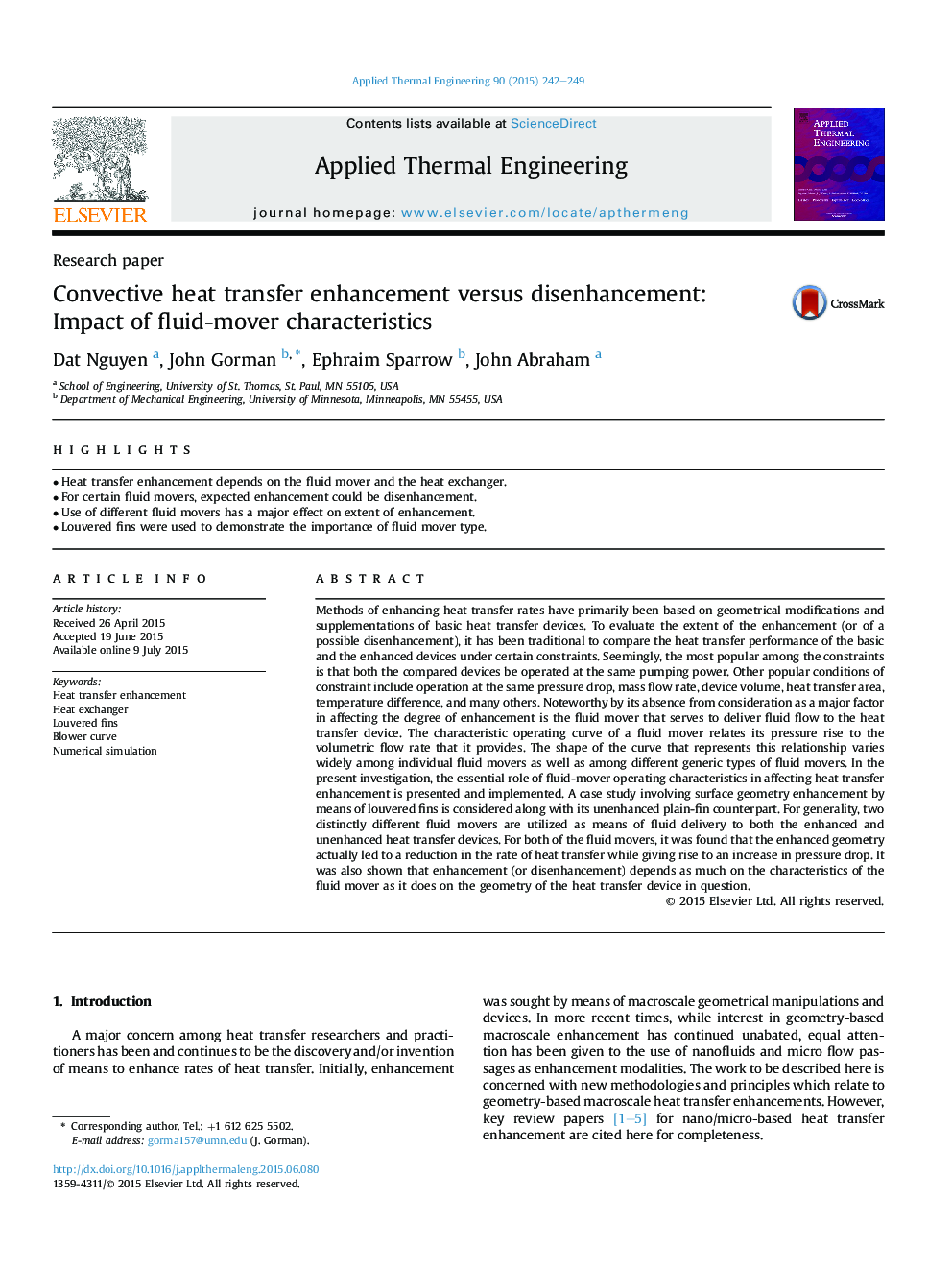| کد مقاله | کد نشریه | سال انتشار | مقاله انگلیسی | نسخه تمام متن |
|---|---|---|---|---|
| 7048831 | 1457138 | 2015 | 8 صفحه PDF | دانلود رایگان |
عنوان انگلیسی مقاله ISI
Convective heat transfer enhancement versus disenhancement: Impact of fluid-mover characteristics
ترجمه فارسی عنوان
افزایش انتقال گرما همراه با انعطاف پذیری: تاثیر ویژگی های مایع
دانلود مقاله + سفارش ترجمه
دانلود مقاله ISI انگلیسی
رایگان برای ایرانیان
کلمات کلیدی
افزایش انتقال حرارت، مبدل حرارتی، باله های نازک، منحنی دمنده، شبیه سازی عددی،
ترجمه چکیده
روش های افزایش میزان انتقال حرارت اساسا بر اساس اصلاحات هندسی و مکمل های دستگاه های انتقال حرارت پایه است. برای ارزیابی میزان پیشرفت (یا عدم امکان افزایش)، مقایسه ای از عملکرد انتقال حرارت دستگاه های اساسی و پیشرفته در محدودیت های خاصی صورت گرفته است. ظاهرا، محبوب ترین در میان محدودیت ها این است که هر دو دستگاه مقایسه شده با همان پمپاژ عمل می شود. سایر شرایط محبوب محدودیت عبارتند از عمل با همان افت فشار، سرعت جریان جرم، حجم دستگاه، منطقه انتقال گرما، اختلاف دما و بسیاری دیگر. نکته قابل توجه در غیاب بودن آن از توجه به عنوان یک عامل عمده در بروز درجه ارتقاء مایع مایع است که در خدمت انتقال جریان مایع به دستگاه انتقال حرارت است. منحنی عامل مشخصه یک مایع حرکت کننده افزایش فشار آن را به میزان جریان حجمی که آن را فراهم می کند، مرتبط می سازد. شکل منحنی که این رابطه را نشان می دهد به طور گسترده ای در میان متغیرهای مایع فردی و همچنین در میان انواع مختلف ژنراتور های مایع متفاوت است. در پژوهش حاضر، نقش اساسی مؤلفه های عملکرد مایع مایع در تأثیرگذاری بر افزایش انتقال حرارت ارائه و اجرا می شود. مطالعه موردی شامل ارتقاء هندسه سطح با استفاده از باله های کرکره ای در کنار همتای غیرقابل مقایسه با دندان های دندانه ای در نظر گرفته می شود. برای عمومیت، دو موتور مایع متمایز متفاوت به عنوان وسیله تحویل مایع به دستگاه های انتقال حرارت پیشرفته و بدون افزایش استفاده می شود. برای هر دو موتور مایع، مشخص شد که هندسه افزایش یافته در حقیقت منجر به کاهش میزان انتقال حرارت شده و در نتیجه باعث افزایش افت فشار می شود. همچنین نشان داده شده است که افزایش (یا عدم تمرکز) به اندازه ویژگی های مایع مایع به اندازه هندسه دستگاه انتقال حرارت مورد نظر بستگی دارد.
موضوعات مرتبط
مهندسی و علوم پایه
مهندسی شیمی
جریان سیال و فرایندهای انتقال
چکیده انگلیسی
Methods of enhancing heat transfer rates have primarily been based on geometrical modifications and supplementations of basic heat transfer devices. To evaluate the extent of the enhancement (or of a possible disenhancement), it has been traditional to compare the heat transfer performance of the basic and the enhanced devices under certain constraints. Seemingly, the most popular among the constraints is that both the compared devices be operated at the same pumping power. Other popular conditions of constraint include operation at the same pressure drop, mass flow rate, device volume, heat transfer area, temperature difference, and many others. Noteworthy by its absence from consideration as a major factor in affecting the degree of enhancement is the fluid mover that serves to deliver fluid flow to the heat transfer device. The characteristic operating curve of a fluid mover relates its pressure rise to the volumetric flow rate that it provides. The shape of the curve that represents this relationship varies widely among individual fluid movers as well as among different generic types of fluid movers. In the present investigation, the essential role of fluid-mover operating characteristics in affecting heat transfer enhancement is presented and implemented. A case study involving surface geometry enhancement by means of louvered fins is considered along with its unenhanced plain-fin counterpart. For generality, two distinctly different fluid movers are utilized as means of fluid delivery to both the enhanced and unenhanced heat transfer devices. For both of the fluid movers, it was found that the enhanced geometry actually led to a reduction in the rate of heat transfer while giving rise to an increase in pressure drop. It was also shown that enhancement (or disenhancement) depends as much on the characteristics of the fluid mover as it does on the geometry of the heat transfer device in question.
ناشر
Database: Elsevier - ScienceDirect (ساینس دایرکت)
Journal: Applied Thermal Engineering - Volume 90, 5 November 2015, Pages 242-249
Journal: Applied Thermal Engineering - Volume 90, 5 November 2015, Pages 242-249
نویسندگان
Dat Nguyen, John Gorman, Ephraim Sparrow, John Abraham,
